| This Wikipedia page has been superseded by Portal:Christianity and is retained primarily for historical reference. |
| Note: Article entries are now being transcluded directly on the main portal page. However, this page should be retained for historical reference. |
The following selected articles appear on Portal:Christianity. The layout for new additions is at Portal:Christianity/Selected article/Layout, which is as follows:
- Current number of selected articles: 23. (Update this number if you add more random articles.)
|
Portal:Christianity/Selected article/1 
Following the Protestant Reformation, the Christian church in several parts of Western Europe, such as Scotland, the Netherlands, certain Swiss Cantons and parts of Germany, adopted a presbyterian polity that did away with bishops altogether. Where ancient cathedral buildings in these lands are still in use for congregational worship, they generally retain the title and dignity of "cathedral", maintaining and developing distinct cathedral functions, but void of hierarchical supremacy. From the 16th century onwards, but especially since the 19th century, churches originating in Western Europe have undertaken vigorous programmes of missionary activity, leading to the founding of large numbers of new dioceses with associated cathedral establishments of varying forms in Asia, Africa, Australasia, Oceania and the Americas. In addition, both the Catholic Church and Orthodox churches have formed new dioceses within formerly Protestant lands for converts and migrant co-religionists. Consequently, it is not uncommon to find Christians in a single city being served by three or more cathedrals of differing denominations. (Full article...) Portal:Christianity/Selected article/2 
The Sermon on the Mount may be compared to the similar but more succinct Sermon on the Plain as recounted by the Gospel of Luke (6:17–49). Opinion is divided as to whether they are the same sermon, similar sermons exploring the same themes, or even that neither sermon really took place but were simply conflations of Jesus' primary teachings as put together by Matthew and Luke. Arguably the best-known segment is the Beatitudes, found at the sermon's beginning. It also contains the Lord's Prayer and the injunctions to "resist not evil" and "turn the other cheek", as well as Jesus' version of the Golden Rule. Other lines often quoted are the references to "salt of the Earth," "light of the world," and "judge not, lest ye be judged." Many Christians believe that the Sermon on the Mount is a form of commentary (midrash) on the Ten Commandments. To many, the Sermon on the Mount summarises the central tenets of Christian discipleship. Portal:Christianity/Selected article/3 
Portal:Christianity/Selected article/4 Portal:Christianity/Selected article/5 
Jesus gave his disciples bread, saying "This is my body," and wine, saying "This is my blood." Christians generally recognize a special presence of Christ in this rite, though they differ about exactly how, where, and when Christ is present. The word "Eucharist" is also applied to the bread and wine consecrated in the course of the rite. The word "Eucharist" comes from the Greek noun εὐχαριστία (thanksgiving). This noun or the corresponding verb εὐχαριστῶ (to give thanks) is found in 55 verses of the New Testament. Four of these verses (Matthew 26:27, Mark 14:23, Luke 22:19, 1 Corinthians 11:24) recount that Jesus "gave thanks" before presenting to his followers the bread and the wine that he declared to be his body and his blood. Most Christians classify the Eucharist as a sacrament, but many Protestant traditions avoid the term sacrament, preferring ordinance. In these traditions, the ceremony is seen not as a specific channel of divine grace but as an expression of faith and obedience of the Christian community. Portal:Christianity/Selected article/6 The Crusades were a series of religious expeditionary wars blessed by the Pope and the Roman Catholic Church, with the stated goal of restoring Christian access to the holy places in and near Jerusalem. The Crusades were originally launched in response to a call from the leaders of the Byzantine Empire for help to fight the expansion into Anatolia of Muslim Seljuk Turks who had cut off access to Jerusalem. The crusaders comprised military units of Roman Catholics from all over western Europe, and were not under unified command. The main series of Crusades, primarily against Muslims, occurred between 1095 and 1291. Historians have given many of the earlier crusades' timeframes. After some early successes, the later crusades failed and the crusaders were defeated and forced to return home. Portal:Christianity/Selected article/7 
Portal:Christianity/Selected article/8 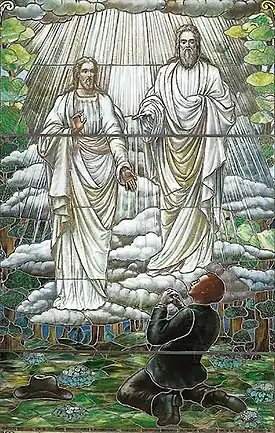
The church teaches that God the Father and Jesus Christ appeared to Joseph Smith, Jr. and called him to be a prophet and to restore the original church as established by Jesus Christ through a restoration of elements that had been missing from Christianity since the early days of Christianity due to apostasy. This restoration included the return of priesthood authority, new sacred texts, and the calling of twelve apostles. The Church was organized under the leadership of Joseph Smith in Fayette, New York, on April 6, 1830, following his translation of the Book of Mormon from which adherents—also called Latter-day Saints—get their nickname Mormons. Joseph Smith led the church until his violent death in 1844. After a period of confusion where the church was led by the Quorum of the Twelve Apostles and various claims of succession were made, Brigham Young led a group of Mormon pioneers away from the former church headquarters in Nauvoo, Illinois, and eventually to the Salt Lake Valley of Utah in July 1847. Brigham Young was sustained as President of the church at General Conference in December 1847. Now an international organization, the church has its world headquarters in Salt Lake City, Utah where Thomas Monson serves as its sixteenth President. The church sends tens of thousands of missionaries throughout the world, and in 2005 reported a worldwide membership of over 12.5 million. Portal:Christianity/Selected article/9 The purpose of the council was to resolve disagreements in the Church of Alexandria over the nature of Jesus in relationship to the Father; in particular, whether Jesus was of the same substance as God the Father or merely of similar substance. St. Alexander of Alexandria and Athanasius took the first position; the popular presbyter Arius, from whom the term Arian controversy comes, took the second. The council decided against the Arians overwhelmingly (of the estimated 250-318 attendees, all but 2 voted against Arius). Another result of the council was an agreement on when to celebrate the resurrection (Pascha in Greek; Easter in modern English), the most important feast of the ecclesiastical calendar. The council decided in favour of celebrating the resurrection on the first Sunday after the first full moon following the vernal equinox, independently of the Hebrew Calendar (see also Quartodecimanism). It authorized the Bishop of Alexandria (presumably using the Alexandrian calendar) to announce annually the exact date to his fellow bishops. The Council of Nicaea was historically significant because it was the first effort to attain consensus in the church through an assembly representing all of Christendom. "It was the first occasion for the development of technical Christology." Further, "Constantine in convoking and presiding over the council signaled a measure of imperial control over the church." Further, a precedent was set for subsequent general councils to create creeds and canons. The long-term effects of the Council of Nicaea were significant. For the first time, representatives of many of the bishops of the Church convened to agree on a doctrinal statement. Also for the first time, the Emperor played a role, by calling together the bishops under his authority, and using the power of the state to give the Council's orders effect. Portal:Christianity/Selected article/10 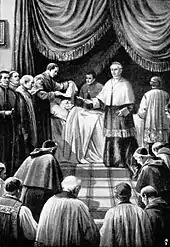
Since the year 1061, the College of Cardinals has served as the sole body charged with the election of the Pope, the source of the term Prince of the church for cardinals. In earlier times, members of the clergy and the people of Rome were entitled to participate, in much the same way as the laity helped determine the choice of bishops throughout the Catholic Church during this early period. Popes may make rules relating to election procedures; they may determine the composition of the electoral body, replacing the entire College of Cardinals if they were to so choose. Portal:Christianity/Selected article/11 
Portal:Christianity/Selected article/12 
Gregorian chant was traditionally sung by choirs of men and boys in churches, or by women and men of religious orders in their chapels. It is the music of the Roman Rite, performed in the Mass and the monastic Office. Gregorian chant supplanted or marginalized the other indigenous plainchant traditions of the Christian West to become the official music of the Roman Catholic liturgy. Although Gregorian chant is no longer obligatory, the Roman Catholic Church still officially considers it the music most suitable for worship. During the 20th century, Gregorian chant underwent a musicological and popular resurgence. |
Portal:Christianity/Selected article/13 Presuppositional apologetics is a field of Christian theology that (1) presents a rational basis for the Christian faith, (2) defends the faith against objections, and (3) exposes the flaws of other worldviews. Presuppositional apologetics is especially concerned with the third aspect of this discipline, though it generally sees the trifold distinction as a difference in emphasis rather than as delineating three separate endeavors. Presuppositional apologetics was developed and is most commonly advocated within Reformed circles of Christianity. The key discriminator of this school is that it maintains that the Christian apologist must assume the truth of the supernatural revelation contained in the Bible (that is, the Christian worldview) because there can be no set of neutral assumptions from which to reason with a non-Christian, and apart from such "presuppositions" one could not make sense of any human experience. In other words, presuppositionalists say that a Christian cannot consistently declare his belief in the necessary existence of the God of the Bible and simultaneously argue on the basis of a different set of assumptions (presumably those of the non-Christian) in which God may or may not exist, and which leave human experience unintelligible. Portal:Christianity/Selected article/14 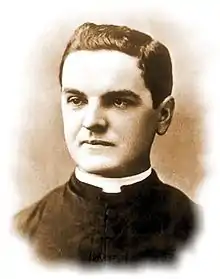
Councils have been chartered in the United States, Canada, Mexico, the Caribbean, Central America, the Philippines, Guam, Saipan, and most recently in Poland. The Knights' official junior organization, the Columbian Squires, has over 5,000 Circles. All the Order's ceremonials and business meetings are restricted to members though all other events are open to the public. A promise not to reveal any details of the ceremonials except to an equally qualified Knight is required to ensure their impact and meaning for new members; an additional clause subordinates the promise to that Knight's civil and religious duties Portal:Christianity/Selected article/15 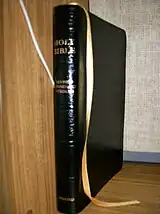
The RSV is a comprehensive revision of the King James Version of 1611, the English Revised Version of 1881-1885, and the American Standard Version of 1901, with the ASV text being the most consulted. It sought not only to clearly bring the Bible to the English-speaking church, but to "preserve all that is best in the English Bible as it has been known and used through the centuries." The copyright to the ASV was acquired by the International Council of Religious Education in 1928, and this Council renewed the ASV copyright the next year. In 1935, a two-year study began to decide the question of a new revision, and in 1937, it was decided that a revision would be done and a panel of 32 scholars was put together for that task. The decision, however, was delayed by the Great Depression. Funding for the revision was assured in 1936 by a deal that was made with Thomas Nelson & Sons. The deal gave Thomas Nelson & Sons the exclusive rights to print the RSV for ten years. The translators were to be paid by advance royalties. Portal:Christianity/Selected article/16 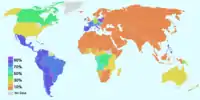
The Catholic Church is by far the largest Christian church and the largest organized body of any world religion. According to the Statistical Yearbook of the Church, the Catholic Church's worldwide recorded membership at the end of 2005 was 1,114,966,000, approximately one-sixth of the world's population. The worldwide Catholic Church is made up of one Western or Latin and 22 Eastern Catholic particular churches, all of which look to the Bishop of Rome, alone or along with the College of Bishops, as their highest authority on earth for matters of faith, morals and church governance. It is divided into jurisdictional areas, usually on a territorial basis. The standard territorial unit, each of which is headed by a bishop, is called a diocese in the Latin church and an eparchy in the Eastern churches. At the end of 2006, the total number of all these jurisdictional areas (or "Sees") was 2,782. Portal:Christianity/Selected article/17 
The shroud is presently kept in the royal chapel of the Cathedral of Saint John the Baptist in Turin, Italy. The Roman Catholic Church has approved this image in association with the devotion to the Holy Face of Jesus. Some believe it is the cloth that covered Jesus when he was placed in his tomb and that his image was somehow recorded as a photographic negative on its fibers, at or near the time of his proclaimed resurrection. Skeptics contend the shroud is a medieval hoax or forgery — or even a devotional work of artistic verisimilitude. It is the subject of intense debate among some scientists, believers, historians and writers, regarding where, when and how the shroud and its images were created. Arguments and evidence cited for the shroud's being something other than a medieval forgery include textile and material analysis pointing to a 1st-century origin; the unusual properties of the image itself which some claim could not have been produced by any image forming technique known before the 19th century; objective indications that the 1988 radiocarbon dating was invalid due to improper testing technique; a 2005 study proving that the sample used in the 1988 radiocarbon dating came from a medieval patch and not the original Shroud; and repeated peer-reviewed analyses of the image mode which contradict McCrone's assertions. Also, pollen from many places the shroud was said to have gone through are found, such as pollen from plants that exist only in certain areas near Jerusalem. Portal:Christianity/Selected article/18 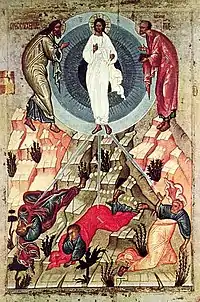
In general, the events in Jesus's life that are said to have taken place in secret, such as the transfiguration, are given less weight by scholars of the historical Jesus than public events. The original Greek term in the Gospels is metamorphothe, describing Jesus as having undergone metamorphosis. The Synoptic Gospels, 2 Peter and the Gospel of John briefly allude to the event in their writings (2Peter 1:16–18, John 1:14). Peter describes himself as an eyewitness "of his sovereign majesty." Neither account identifies the "high mountain" of the scene by name. The earliest identification of the mountain as Tabor is in the 5th century Transitus Beatae Mariae Virginis. In the apocryphal Gospel of the Hebrews, Jesus tells how his mother lifted him up by the hair and lifted him to Mount Tabor, which led Origen to identify the Holy Spirit as the Mother of Jesus. Symbolic readings take Moses and Elijah to represent the Law and the Prophets respectively, and their recognition of and conversation with Jesus symbolize how Jesus fulfils "the law and the prophets" (Matthew 5:17–19, see also Expounding of the Law). In the narrative, after the cloud dissipates, Elijah and Moses disappear, and Jesus and the three Apostles head down the mountain, Jesus telling his Apostles to keep the event a secret until the "Son of Man" had risen from the dead. The Apostles are described as questioning among themselves as to what Jesus meant by "risen from the dead" (Mark 9:9–10) The Apostles are also described as questioning Jesus about Elijah, and he as responding "...Elijah comes first, and restores all things ... but ... Elijah has come indeed ..." (Mark 9:12–13). It was commonly believed that Elijah would reappear before the coming of the Messiah, as predicted in the Book of Malachi (Malachi 4), and the three Apostles are described as interpreting Jesus' statement as a reference to John the Baptist. Portal:Christianity/Selected article/19 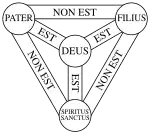
Portal:Christianity/Selected article/20 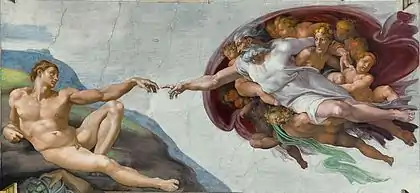
Portal:Christianity/Selected article/21 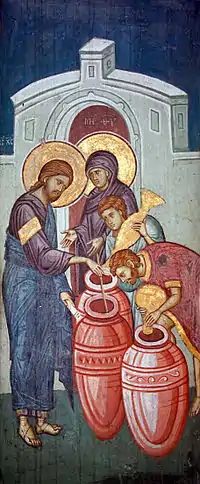
In the mid-19th century, some Protestant Christians moved from a position of allowing moderate use of alcohol (sometimes called moderationism) to either deciding that not imbibing was wisest in the present circumstances (abstentionism) or prohibiting all ordinary consumption of alcohol because it was believed to be a sin (prohibitionism). Many evangelical churches, particularly the Methodists, advocated abstentionism and were early leaders in the temperance movement of the 19th and 20th centuries. Today, all three of these positions exist in Christianity, but the historic position remains the most common worldwide, due to the adherence by the largest bodies of Christians, namely Anglicanism, Roman Catholicism, and Orthodoxy. Portal:Christianity/Selected article/22 
The doctrine emphasizes the importance of personal empowerment, proposing that it is God's will for his people to be happy. The atonement (reconciliation with God) is interpreted to include the alleviation of sickness and poverty, which are viewed as curses to be broken by faith. This is believed to be achieved through donations of money, visualization, and positive confession. It was during the Healing Revivals of the 1950s that prosperity theology first came to prominence in the United States, although commentators have linked the origins of its theology to the New Thought movement which began in the 19th century. The prosperity teaching later figured prominently in the Word of Faith movement and 1980s televangelism. In the 1990s and 2000s, it was adopted by influential leaders in the Charismatic Movement and promoted by Christian missionaries throughout the world. Prominent leaders in the development of prosperity theology include E. W. Kenyon, Oral Roberts, TD Jakes, A. A. Allen, Robert Tilton, T. L. Osborn, Joel Osteen, Creflo Dollar, Kenneth Copeland, Reverend Ike and Kenneth Hagin. Prosperity theology has been criticized by leaders in various Christian denominations, including within the Pentecostal and Charismatic movements, who maintain that it is irresponsible, promotes idolatry, and is contrary to scripture. Portal:Christianity/Selected article/23 
It was launched on 27 November 1095 by Pope Urban II with the primary goal of responding to an appeal from Byzantine Emperor Alexios I Komnenos, who requested that western volunteers come to his aid and help to repel the invading Seljuk Turks from Anatolia. An additional goal soon became the principal objective—the Christian reconquest of the sacred city of Jerusalem and the Holy Land and the freeing of the Eastern Christians from Muslim rule. During the crusade, knights, peasants and serfs from many regions of Western Europe travelled over land and by sea, first to Constantinople and then on towards Jerusalem. The Crusaders arrived at Jerusalem, launched an assault on the city, and captured it in July 1099, massacring many of the city's Muslim and Jewish inhabitants. They also established the crusader states of the Kingdom of Jerusalem, the County of Tripoli, the Principality of Antioch, and the County of Edessa. The First Crusade was followed by the Second to the Ninth Crusades. It was also the first major step towards reopening international trade in the West since the fall of the Western Roman Empire. Due to the First Crusade being largely concerned with Jerusalem, a city which had not been under Christian dominion for 461 years, and that the crusader army, on seizure of lands, had refused to honour a brokered promise before the seizure to return gained lands to the control of the Byzantine Empire, the status of the First Crusade as defensive or aggressive in nature remains unanswered and controversial. The majority view is that it had elements of both in its nature.
|
Historical archive
Before May 2011 the portal was configured to show one selected article per month. Use this section to browse these older selections, but do not attempt to set up any new monthly selections this way.